From Riksgränsen to Oslo
Fjords and wooden fishers' huts on poles
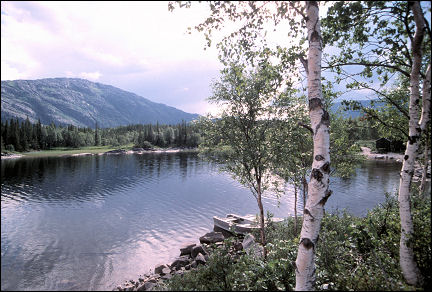
|
From Riksgränsen in Lapland descending to Oslo one passes by countless fjords, lined with wooden houses, sometimes built on poles in the water. Rivers plunge with deafening noise into the sea via waterfalls, high bridges span straits, codfish, suspended on racks are drying to become stockfish and traffic signs warn you for crossing elks and reindeer.
Travelogue & photos: Mariet Arts
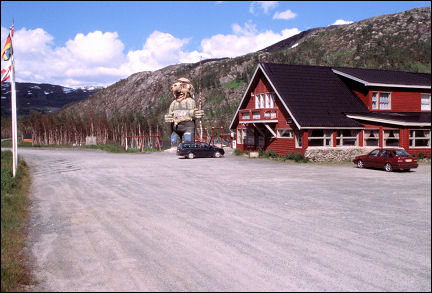
|
The sunny weather with which we left Sweden, stays with us when we drive on the E10 through a wild Norwegian landscape. We have lunch at a road restaurant. Beside the entrance a huge troll stands guard. The birches we see when we continue our trip are irregularly shaped and much smaller than the giant troll.
We are now more than 200 km (135 miles) above the polar circle in the province of Nordland. In Traeldal we turn right and keep following the E10, which here joins the E6, along the deep blue Ofot fjords. In the distance the white tower of the Bjerkvik church stands out beautifully against the dark mountains. Their peaks are still covered with snow.
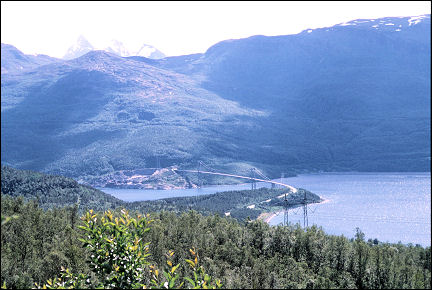
|
Ten minutes later we stop in front of hotel Bjerkvik in the Northernmost part of the Ofot fjords. After checking in we have dinner at Det lille kjøkken (the small kitchen): a 'berømte Bjerkviking', a hamburger with bacon, peppers and garlic sauce.
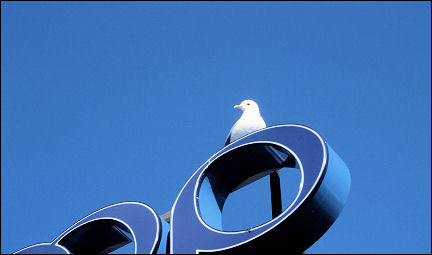
|
It is a beautiful summer evening. People are walking and sitting outside. Snow white gulls are waiting patiently for snacks. The midsummer night's sun provides an unforgettable atmosphere.
Vesterålen
At 1 AM the sun disappears behind the mountains
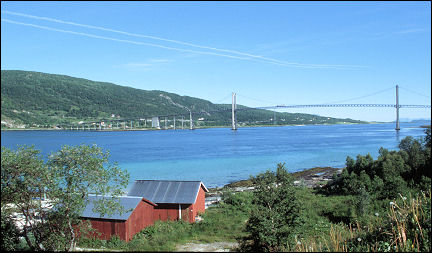
|
After a hearty Norwegian breakfast next morning we drive around the fjord to Bogen. Via the Tjeldsundbro (bridge) we cross the Tjeldsund which is connected to the Vågs fjord and then we are on Hinnøya.
Hinnøya is one of four islands which form the Vesterålen; it is an area of 20.000 km² and Norway's largest island. It has become the center of 'Spekkhoggersafari' (whale safaris) for tourists.
Via Kilbotn we arrive in Harstad, the capital of the Vesterålen. In the Kulturhus (Culture house) on the harbor is a tourist office where we find information about Harstad and surroundings. In the harbor is docked the schooner Anna Rogde (1868), the oldest sailing ship in the world. A group of volunteers, which calls itself "Friends of Anna Rogde", are preparing the ship for a day trip dressed as pirates.
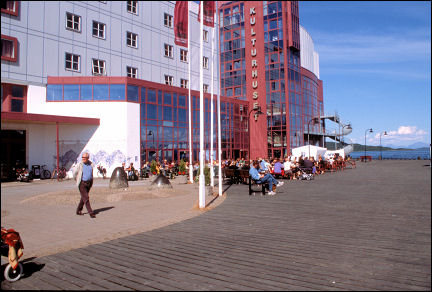
|
The annual North Norway Festival dominates Harstad with music, theater, art and dance from different European countries. It's pleasantly crowded in stores and outdoor cafés, there is much to see and time flies.
After midnight we arrive at the camping grounds where we rent a hytte (cabin) for one night. The cabin has all conveniences and looks out on the Vågs fjord. When the sun disappears behind the mountains around 1 AM, the light becomes so mysterious, so beautiful, that it's a pity I have to go to sleep.
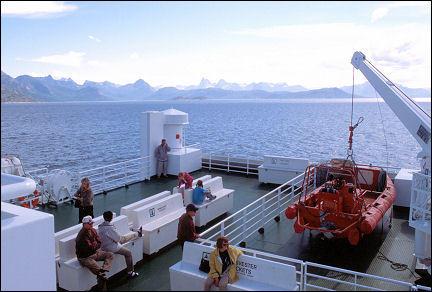
|
We leave the camping grounds at 9 AM and drive back to Kilbotn. Via Sandtorg, Kongsvik and Fiskfjord we arrive inLødingen where we take the ferry and cross the Tysfjorden to Bognes. Despite the fog the view from the ferry is fairy tale blue.
Still overwhelmed by the experience, we leave the ferry and drive South. We approach Hamarøy, where author Knut Hamsun lived since he was three years old, in a farm that now is a museum.
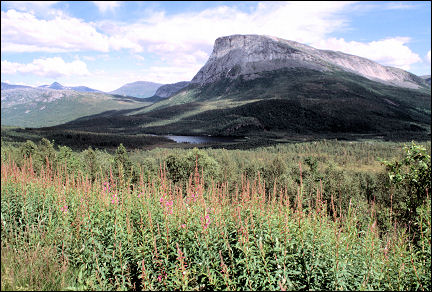
|
We drive in the district Hamarøy on the E6, which passes many villages: Sommerset, Kråkmo and Sildhopen. All of a sudden we see the Pink Panther, Barney, Pluto and other bigger than life cartoon characters, also Norwegian ones.
The cartoon characters are randomly scattered: they stand in gardens, along the side of the road, always accompanied by a sign that reads: Vennligst ikke rør oss (please, don't touch). But who wouldn't want a picture of themselves with Pluto or a tough Viking?
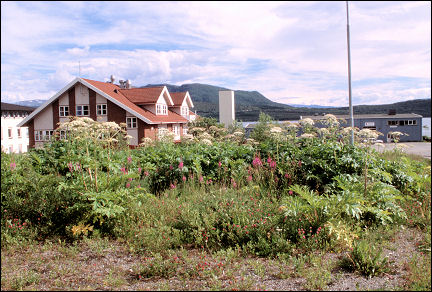
|
After a beautiful drive along deeply indented fjords, fantastic views and 15 tunnels, we arrive in Fauske, famous for its marble, with big modern buildings and huge hogweeds.
Bodø
Most houses and sheds have grass roofs
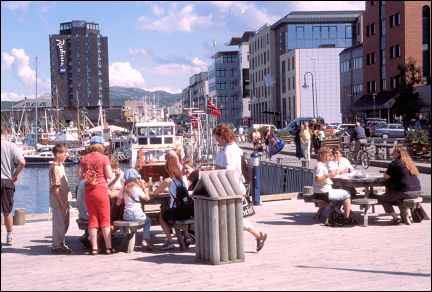
|
It is getting warm already when we drive along the Salts fjords next morning towards Bodø, the second biggest city in North Norway. We easily find a parking place for our car in the city center and walk to the port, where it is pleasantly crowded. Reker (shrimp)is sold directly from the fishing boats.
In the visitors center we are told that we are now in sea eagle territory. We can join a sea eagle safari, or we can visit the Saltstraumen, 33 km South of Bodø, the strongest maelstrom in the world.
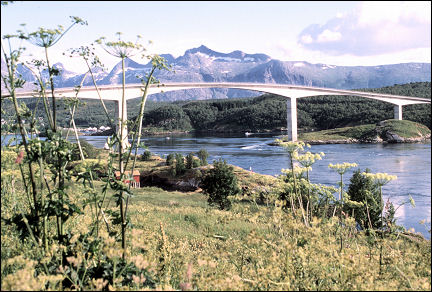
|
We visit the Saltstraumen, a 2.5 km long, 150 m wide and up to 50 m deep sound between two islands, Straumen and Straumøy, wich connects the Salt fjord to the Skerstad fjord.
During the changing of the tides 350 million square meters of water is squeezed through this sound, which causes whirlpools.
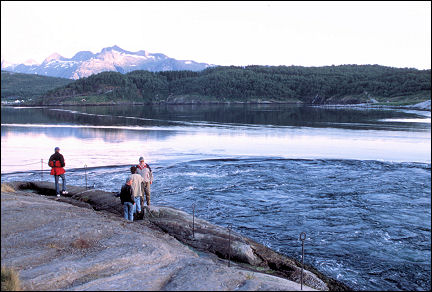
|
We go in the afternoon. A multi-media show explains the tides, the myths and legends about the Saltstraumen, its history and fauna.
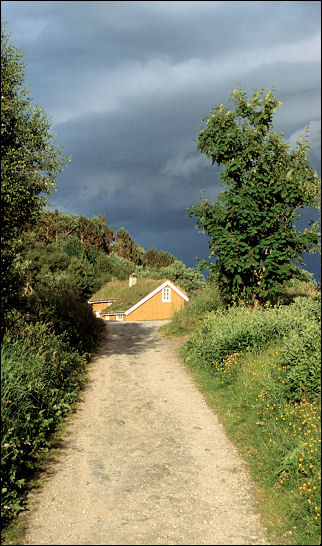
|
On the way back the low sun blinds us and we almost collide with a group of elks standing in the middle of the road. They refuse to step aside. Very, very slowly we keep driving.
Just outside Bodø, next to the open-air museum, is a vacation home park where we spend the night in one of their cabins.
Most houses and sheds in the Bodøsjøen museum have grass roofs and have been brought here from different parts of the country. Gulls have their nests in the grass on the roofs.
Many different kinds of flowers grow here in the wild, among which Norwegian monkshood and alpine marram.
We take many walks in this pretty area. During one of them, the air all of a sudden turns black. Just in time before a heavy thunderstorm we reach our cabin maken veel wandelingen door dit mooie gebied.
Signs warn for crossing elks and reindeer
Extra carefully and on the alert we drive on
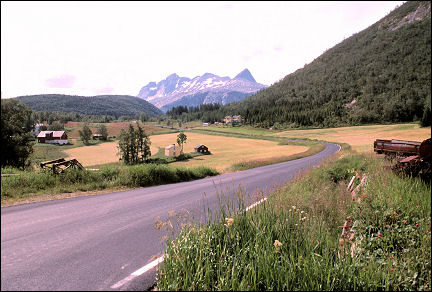
|
After three days of lazyness, looking around and hiking we continue our trip. We drive over the high Saltstraumen bridge from the Salt fjord to Tuv. Via a hilly area, mountains with snowy peaks and little villages we reach an altitude of 1286 m and find ourselves in the snow.
Wherever the snow has melted, yellow and orange clumps of gullbräcka (saxifrages).
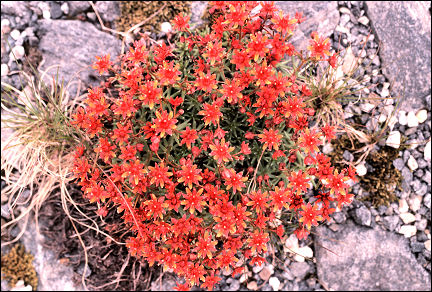
|
We stop at the side of the road, but it's very cold, so we get back in the car immediately. Via the Misvær fjords we reach Misvær. Near Vestvatn we take the 813, direction Storjord and arrive in Beiarn, a hamlet on the Beiar fjords. It is as if time has stood still here, it's so quiet and peaceful.
Outside the community center are tables and chairs. Inhabitants of the hamlet sit there, listening to musicians singing Norwegian folk songs. There is a gatekjøkken kiosk htat sells snacks, sweets and alcohol-free drinks. On a field next to it are tents and stalls that sell angling equipment.
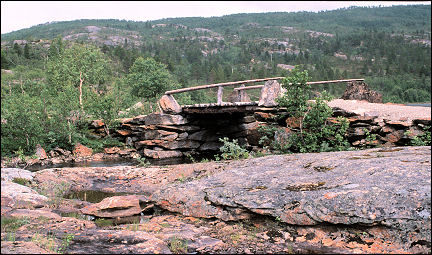
|
Next day we drive to the 812 and take a right turn near Kjøttan. At the end of this road we take the E6 through the Salt Valley in southern direction.
Near Storjord, where the National Forestry School is, is the entrance to the hiking area Junkerdal, famous for its flora.
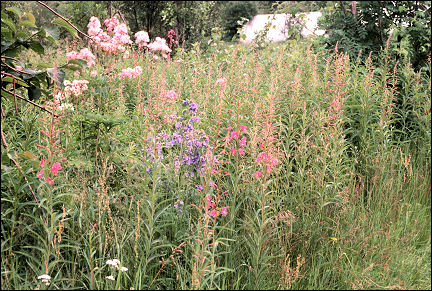
|
We drive on the high plains of Saltfjell. Several times we notice signs that warn us for crossing elks and reindeer. In the distance are railway tracks which are partly covered by long, wooden tunnels and high fences which protect the trains against the snow.
We've reached the polar circle and visit the Polarsirkelsenteret. This center is remarkable for its architecture, which is adapted to nature. The polor circle itself is made visible throughout the building. It has a post office where picture postcards get a polar circle stamp.
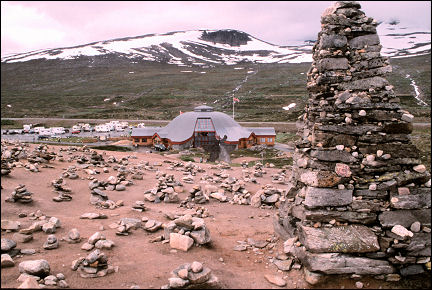
|
This is a place we'd like to visit again and so we build a small tower of stones, between the hundreds that are already here, following an old Sami ritual.
When we are on our way again, we all of a sudden see people standing in the middle of the road, waving their arms to indicate that we should slow down. There is a car, completely wrecked, next to it lies a dead elk. We move as far to the right side of the road as possible to make way for police and ambulance which are arriving with screaming sirens. Even more carefully and alert we continue our drive.
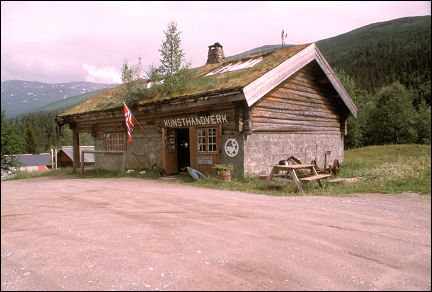
|
In the miners village Storforshei we visit Øyvind en Sølvsmie Stjernen's gallery. By the door are large green metal insects and inside there are two floors of silver objects and jewelry.
The roof, which is overgrown by grass, flowers and small trees, has large windows, so there is enough light. In the background I hear music I like in a language that sounds unfamiliar. I ask Sølvsmie what it is. She tells me that it is Mari Boine, a Sami singer.
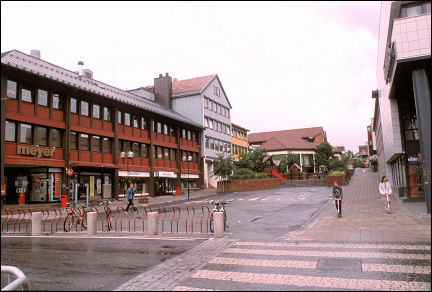
|
It pours when we enter Mo i Rana and park our car near the railway station. The center of Mo is empty, everyone has fled inside. We look around in Mo Libres, an immensely big book store. It has many books about Norwegian art, flora and fauna.
When we go outside, it is still raining. That's a pity, because now there is no point in climbing the Mofjell (410 m) to enjoy the view of the city and the Svartisen glacier.
Mosjøen
We enjoy the great view of city and fjord
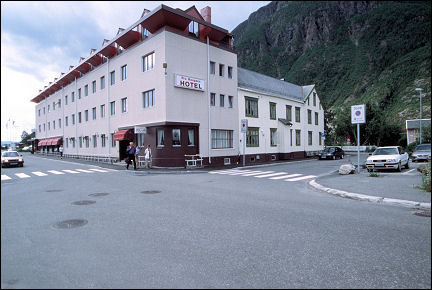
|
Mosjøen is in the Vefsn region and we think it might be fun to spend a few days here and stay in Fru Haugans Hotel (1794). It is the oldest wooden hotel in North Norway and it has an interesting history. I ask about it at the reception and Bodil tells us the whole story.
In 1885 Fru (Mrs.) Ellen Haugan sees an ad in the newspaper that offers an almost hundred years old hotel for sale. She buys it unseen. Her husband is ill and she has three daughters, so she has to provide for the family.
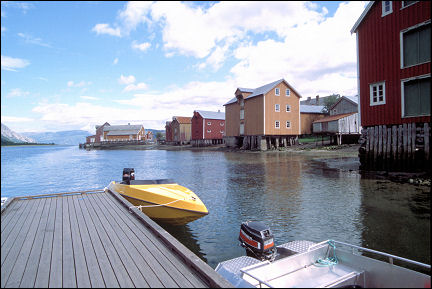
|
It is not a modern hotel, the kitchen doesn't have a real floor and there is no heating. Through hard work Ellen soon makes the hotel well-known and loved for its good food, service and atmosphere.
Ellen Haugan dies in 1921 and her daughter Eli inherits the hotel. She adds 40 rooms in a stone extension of the old wooden hotel. Eli dies in 1962 and her niece Eli Jürgensen takes over the hotel and so continues the tradition as the third generation of women.
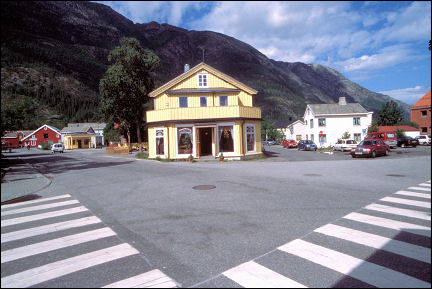
|
In 1991 a niece of Eli's, Bjørg Jürgensen moves with her family from Kristiansund to Mosjøen to take over the direction of the hotel. She restores all rooms, adds a new restaurant, conference rooms, a bar, a new lobby and an elevator.
At the same time she takes care of the old part and renovates the old-style rooms by adding modern amenities.
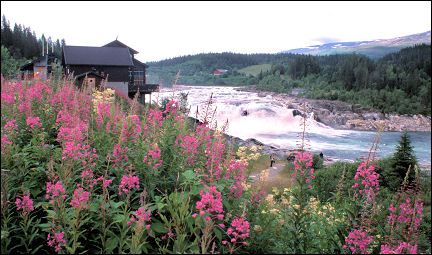
|
Bodil, the woman who tells us this story, is since 2002 the fifth generation of women who lead the hotel. The garden of the hotel is on the Vefsna, where hotel guests can fish for salmon and sea trout.
Mosjøen is a pleasant tourist town with many historical sights. We feel at home immediately. Opposite the department store Domus children play with a large chess board which sits on the square. We visit the 18th century wooden fishers cottages which have been renovated and are a museum now. The husfliden store has pretty needlework and souvernirs. On the Haravoll we enjoy a wonderful view of the town and the fjord.
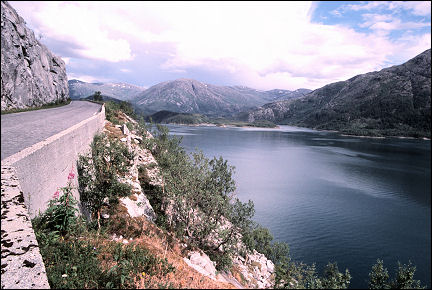
|
Driving on the E6 again, we follow a fast flowing river. We pause by a café. Accompanied by a deafening noise, the Lakfors, a 17 meters high waterfall throws itself down via a few platforms.
A dirt path takes us down to the river, where we enjoy this unique sight. Unfortunately we don't see any salmon jump and swim against the current.
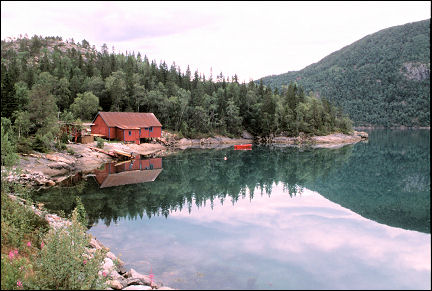
|
After a few miles we leave the E6 and take the Tosenveien, Rv76, West-bound. The sun shines, it's nice and warm. From the brightness of the day we enter the dark Tosen Tunnel and just in time avoid running over some sheep with their lambs, hiding from the sun in the cool shade of the tunnel.
The Tosen Tunnel is 5.800 m (17.400 feet) long. After we pass by Tosbotn we arrive at the Tosen Fjord which is so blue, that we simply have to stop for a while to enjoy it.
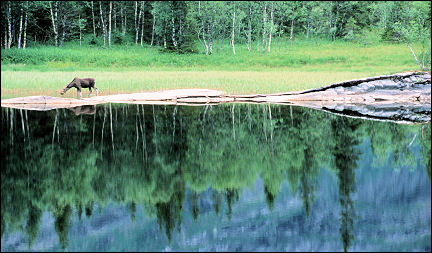
|
Next morning near our hytte (cabin) on the lake an elk is grazing, but she bolts as soon as she sees us.
Meanwhile the water beckons us. We get a small boat and sail it between deserted islands, where we climb rocks and pick berries. Late in the evening we take a walk in the forest, where we see elks, owls and different kinds of wild flowers.
Fosen
Fishers cottages on poles in the water
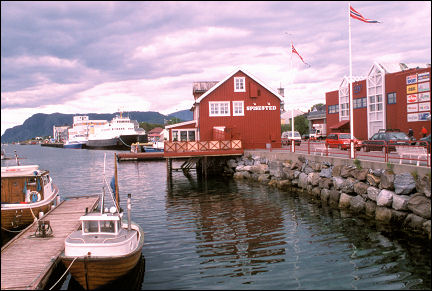
|
Two days later we drive farther West and visit Brønnøysund on the Vega fjord. While we're driving on the coastal road, we see the island Torget in the distance. The sea has carved an impressive hole in Torghatten mountain.
Farmhouses and boat houses on the sea stand out against the background of steep mountains.
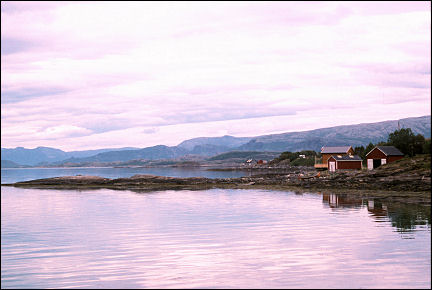
|
We pass by Sømna, North Norway's most important agricultural area. Via Berg and Vik we reach Vennesund where we take the ferry and cross the Horta fjord to Holm. The wild natural landscape is overwhelming. In the evening we arrive in Namsos.
On the peninsula Fosen we search for robuer the next day. Originally these were fisher cottages on poles in the water. In Bessaker there are five, each with two floors and a view of the sea. We stay here for a couple of days.
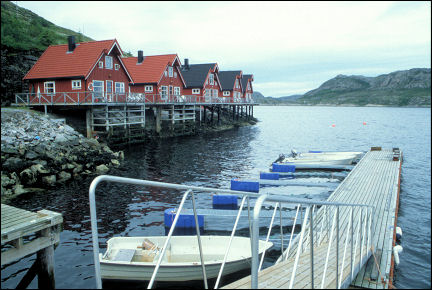
|
Het back of the cottage is built on the rocks, which are overgrown with polarull, a kind of Q-tips on stalks, and the front rests on long poles in the water. There is a landing with small boats.
Fishers sail out and when they come back with their catches, there is a lot of activity at the spot where the fish is cleaned. Big gulls fight screaming over the waste and in no time they have gobbled up everything, then it gets quiet again.
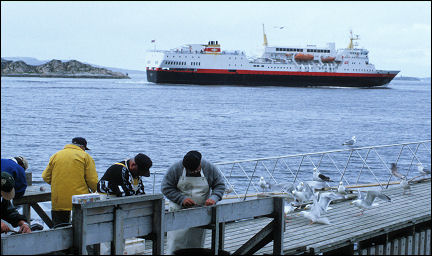
|
Enormous ships sail by on the Hurtigrute. They sail all along the Norwegian coast, from Bergen to Kirkenes at the Russian boarder. In the kro we order the 'dagens rett', menu of the day. It is a buffet with different Norwegian dishes.
Now that we're farther away from the Polar Circle, it gets dark for a few hours at night, but by 5 AM the sun is already high in the sky.
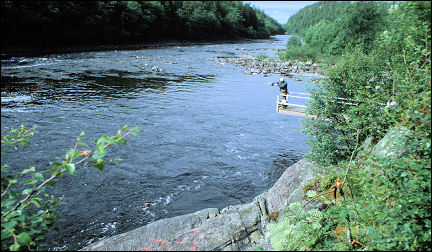
|
We leave early for an island tour. In Åfjord a Norwegian Fjord horse is harnessed to a carriage with a bridal couple in it. A photographer is busy taking pictures of the whole family.
Near Støvelfossen, in the salmon river Stordalselva, one of the fishermen has caught a salmon; the news spreads like a wildfire among the anglers who standing in and by the river. They abandon their fishing rods to take a look at the caught salmon.
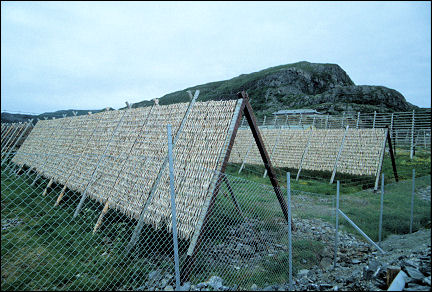
|
In Revsnes we see many racks along the coast on which codfish are drying. In Råkvåg are well preserved warehouses on poles. The oldest one is 150 years old. "Culture warehouse" Salteriet has an exhibition about herring fishing. Along the road and on the rocks are thousands of succulents in many colors.
Dovrefjell
Big patches of fog hang between the mountains
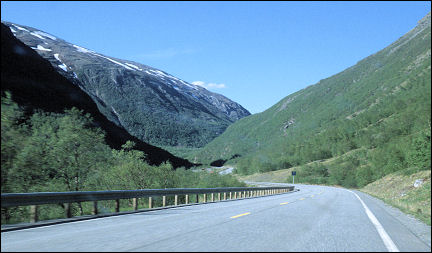
|
After three days we leave Fosen. We take the ferry from Rørvik to Flak over the Trondheim fjord. We're close to Trondheim, an old city with a cathedral where Norwegian kings are crowned.
We get back to the E6 and through the Gaul Valley we arrive in Oppdal, a mountain town at an altitude of 550 meters in the foothills of the national parks Dovrefjel and Trollheimen which house the most beautiful mountains of Norway.
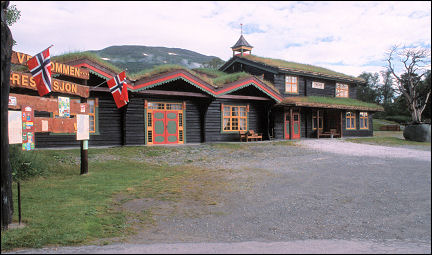
|
It is pouring when we arrive at camping site Halsetløkka. By the entrance is an old train station, built in 1921. We rent a hytte and despite the rain we take a walk in the town.
In a ceramics studio I talk with one of the craftsmen. He tells me that the impressive natural surroundings of Oppdal, forests and mountains, rivers, lakes and high plains, unique flora and fauna are an inspiration not just for him, but also for many other creative people of the "Oppdal Håndverk".
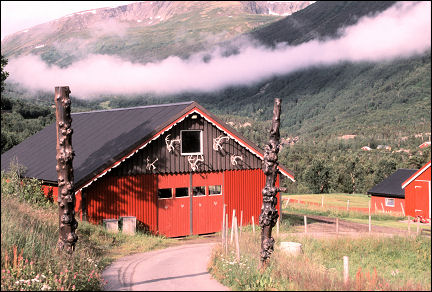
|
Nest morning the sun is shining again. There are big patches of fog in the mountains. We pass by a black wooden train station and the Sami camp "Same Jakki's." Hundreds of goats are climbing the steep rocks, it is a miracle that they don't slip with their tiny legs and fall into the canyon.
In Kongsvoll on the E6 is a fjellstue (mountain inn). Behind the fjellstue is a botanical mountain garden. In Knutshø and Dovrefjell 420 different kinds of plants have been catalogued. The mountain inn was built in the 17th century and has a café and a museum with historic objects from Kongsvoll. There also is a scientific research center.
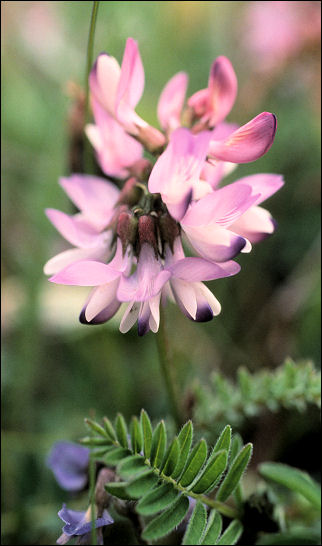
|
We drive on the Dovrefjell, a mountain plain at 1000 meters, surrounded by even higher mountain peaks. It's even more gorgeous than I expected. Apart from elks and reindeer also herds of wild musk oxen live here. The area has an exceptionally rich flora with rare alpine plants like gentian, moon ferns and glacier buttercups.
Time to get active, we're going to hike. At first we follow the trail, but soon we start wandering. The ground is covered with lichen and small shrubs. All of a sudden I see, right in front of me, a small sky-blue star and yes, it is gentian! My day is perfect when I discover a little while later also Norwegian bedstraw, alpine tragant and moss violets.
The Dovre massive was the empire of the Mountain King, the mightiest and friendliest of all Trolls. In the Trollstua souvenir shop in Dombås we find out everything about the trolls of Dovrefjell and we can't keep ourselves from buying a few trolls.
"Rømmegrøt" we read on a wooden sign on the side of the road. We're going to find out what it means. After a while we find ourselves driving among lots of campers, trailers and dog carts. Within a fenced in patch of grass land people are showing off their dogs and a jury will eventually select a winner. On the menu of a nearby eatery is Rømmegrøt with Spekemat. A little later we are served to plates of porridge with cinnamon and butter, accompanied by a plate of smoked raw ham. This is a traditional Norwegian dish.
Gudbrands Valley
Woods, farmlands and villages in a beautiful mountain landscape
Gudbrands Valley is the longest valley of Norway with its length of over 200 km. It has woods, farmlands and picturesque villages, surrounded by a beautiful mountain landscape. To the West are the wild hills of the Peer Gynt area and to the East the peaks of the Rondane mountains rise up.
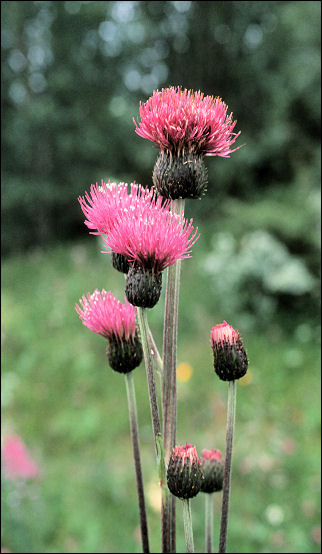
|
In the Gudbrands Valley we are surprised by the huge stately farmhouses where for centuries the gentleman farmers reigned.
We drive through Otta, a town with ochre wooden houses. In the center there are every few meters huge concrete containers with red geraniums. In Kwam we visit the cross-shaped church designed by Magnus Poulsson. The wood carvings are made by inhabitants of the valley.
Just before Ringebu signs show the way to a stavkirke. The wooden stavkirken are the most well-known and characteristic examples of medieval architecture. During the Summer the church is open to the public. Its clocktower sits on a slope, surrounded by a wall of big grey stacked stones.
In Hunderfossen family park sits the biggest troll in the world. One enters the park by walking underneath it.
We pass Lillehammer by and drive on the right side of Lake Mjøsa, Norway's largest lake.
We follow signs with a little house on them and arrive in a vacation home park. There is no reception. But there is a small shack near the entrance with a little girl in it. When we ask if we can stay for the night, she hands us the keys of four cabins which are still unoccupied. We can choose one ourselves, she says.
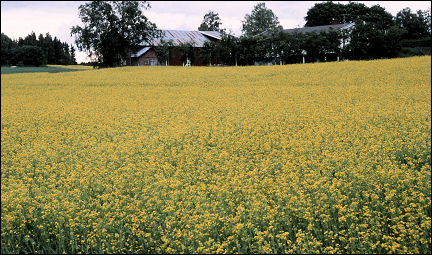
|
Next day we pass by Jevnaker on the Sourhernmost part of the 73 km long Rands fjord. Driving along rape fields and roadsides full of kvitbladtistel, (a kind of thistle), the protected scabiosa and verbascum thapsus we arrive in Hønefoss.
In the parking lot where we stop for a short break are "Porfyrkongen" of volcanic rock and "Steinsdronningen" of sandstone. They are local kinds of rock. The "king" and "queen" are made by the artist Svein Knudsen. They look on the Tyri fjord.
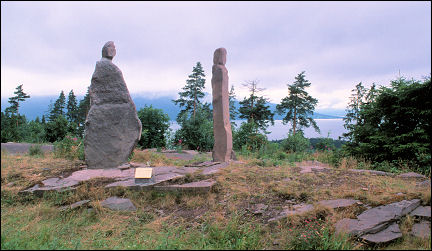
|
The "Crownprince Harald" is docked in the port of Oslo fjord. We have enough time to board for the 19 hours trip to Kiel in Germany. Filled with nostalgia we stand at the railing and think about our adventures.
There is so much more to discover, so one thing is certain: we'll be back.